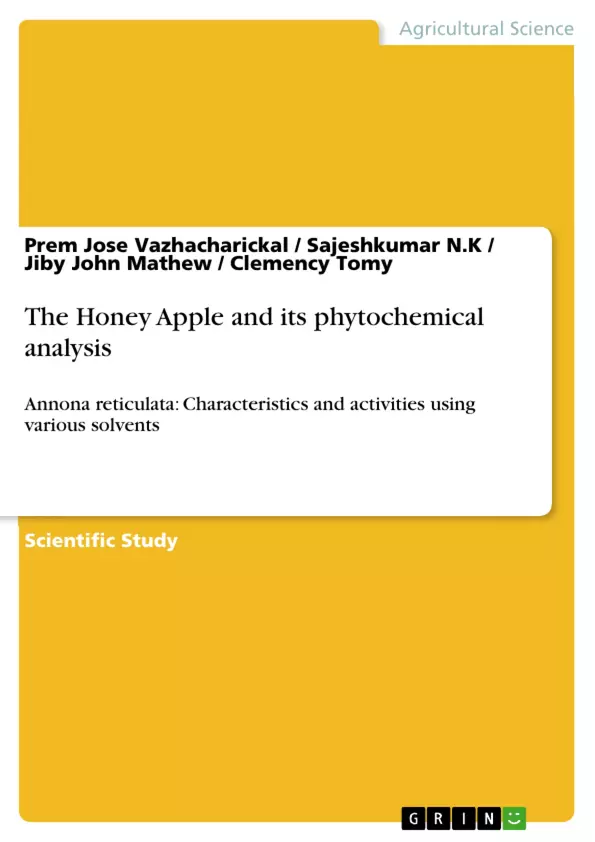This study aims at the attributes of the Annona reticulata and its medical and biological value.
Annona reticulata belongs to the family Annonaceae, commonly known as honey apple. Qualitative phytochemical analysis of chloroform and water extracts of Annona reticulata fruit, leaf and stem bark was conducted in order to detect the presence of various secondary metabolites using standard procedures. The results of phytochemical screening indicated the presence of secondary metabolites such as tannins, betacyanins, carbohydrates, alkaloids, terpenoids, phenols, quinines, saponins, cardiac glycosides etc. Also the comparative antimicrobial activity of chloroform and water extracts of fruit, leaf and stem bark of Annona reticulata was evaluated against four bacterial species namely, Escherichia coli, Pseudomonas aeruginosa, Serratia marcescens and Micrococcus luteus and two fungal species namely Candida albicans and Rhizopus. Agar well diffusion method and disc diffusion method were selected to check the antimicrobial activities of the extracts. The study revealed that the chloroform extracts of leaf, stem bark and fruit of Annona reticulata has activity against the bacterial strains and fungal strains. Whereas, the water extracts of leaf, fruit and stem bark of Annona reticulata has more activity towards the fungal species. The findings of this study have identified that Annona reticulata extracts acts as a promising source of antimicrobial agent which could be useful in the modern medicine.
Inhaltsverzeichnis (Table of Contents)
- 1. Introduction
- 1.1 Objectives
- 1.2 Scope of the study
- 1.3 Taxonomical classification
- 2. Review of literature
- 2.1 Uses and importance
- 3. Hypothesis
- 4. Materials and Methods
- 4.1 Study area
- 4.2 Sample collection
- 4.3 Preparation of extract
- 4.4 Phytochemical analysis
- 4.5 Isolation of microorganisms and mass culture
- 4.6 Antimicrobial activity
- 4.7 Antimicrobial susceptibility testing
- 4.8 Statistical analysis
- 5. Results and discussion
- 5.1 Phytochemical screening
- 5.2 Antibacterial susceptibility tests
- 6. Conclusions
Zielsetzung und Themenschwerpunkte (Objectives and Key Themes)
The study aimed to investigate the phytochemical composition and antimicrobial activity of the Annona reticulata fruit. The study focused on extracting phytochemicals from the fruit using various solvents and testing their effectiveness against a range of bacterial and fungal strains.
- Phytochemical analysis of the Annona reticulata fruit
- Antimicrobial activity of extracts against various microorganisms
- Evaluation of the effectiveness of different solvents in extracting phytochemicals
- Determination of the potential medicinal properties of the Annona reticulata fruit
Zusammenfassung der Kapitel (Chapter Summaries)
The introduction provides background information on the Annona reticulata fruit, its taxonomic classification, and the objectives and scope of the study. The review of literature explores the various uses and importance of the fruit. Materials and Methods outlines the study area, sample collection, preparation of extracts, phytochemical analysis, isolation and mass culture of microorganisms, and the antimicrobial activity testing process. The results and discussion section presents the findings of the phytochemical screening and antibacterial susceptibility tests.
Schlüsselwörter (Keywords)
Annona reticulata, phytochemical analysis, antimicrobial activity, solvents, bacterial strains, fungal strains, medicinal properties.
- Quote paper
- Dr. Prem Jose Vazhacharickal (Author), Sajeshkumar N.K (Author), Jiby John Mathew (Author), Clemency Tomy (Author), 2016, The Honey Apple and its phytochemical analysis, Munich, GRIN Verlag, https://www.hausarbeiten.de/document/359168


